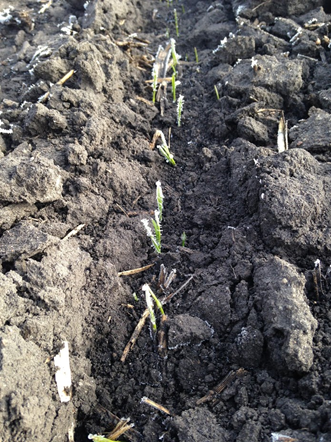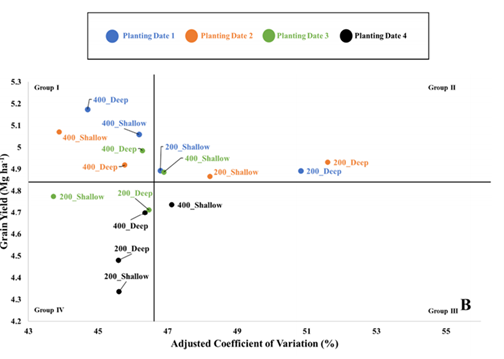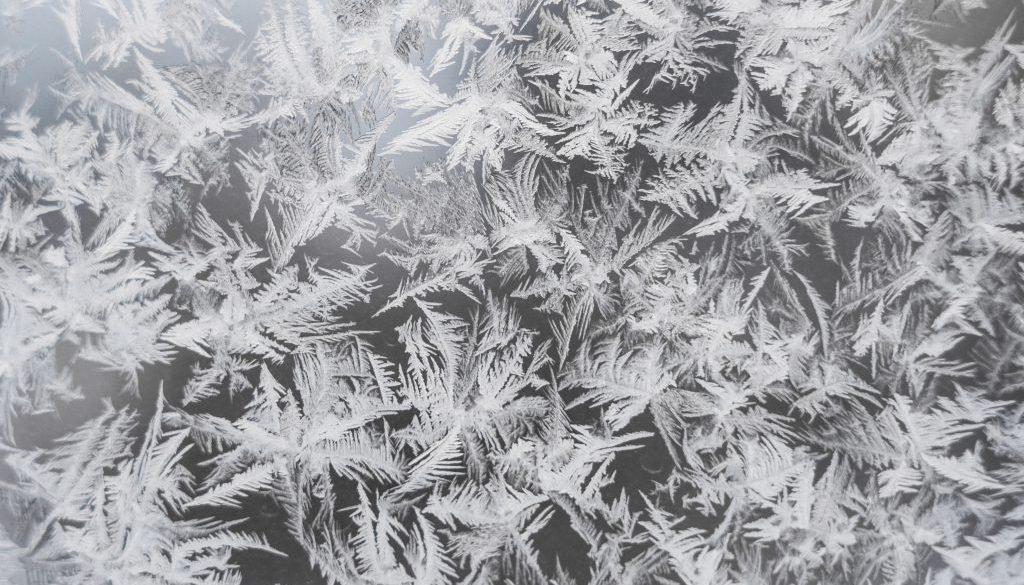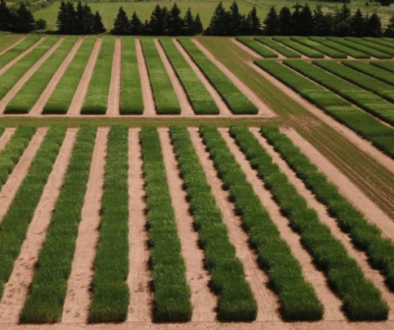Spring Frost Risks in Cereal Crops
When emerged cereal crops experience night-time temperatures below 0°C, the question of crop survival is never far from a producer’s mind. In general, wheat is relatively resilient to frost as compared to crops like canola. Wheat leaves can survive air temperatures down to -8°C to -10°C, however, leaves may see some leaf tip burn. This is indicated by recent research investigating ultra-early seeding of CWRS wheat (Collier et al., 2021). Barley is less resilient and will exhibit frost damage at temperatures closer to -4°C to -6°C (R. McKenzie, personal communication). Minimal frost tolerance research on barley has been conducted. However, the chance of plant death is low at these temperatures, especially when soil temperatures are warmer. Warmer soil, and especially moist soil, is buffered from temperature changes which helps to protect the growing point of cereals from late spring frost. This is due to wheat and barley plants having their growing point under the soil surface until stem elongation (begins after the 3 leaf stage and tiller initiation) when the inflorescence, or developing head, begins to move above the tillering node. The growing point of the plant must be damaged for the plant to die. For this to happen, extended time periods below freezing would need to occur. If only the leaves are damaged, the plant can grow back from that protected growing point, but the crop will be delayed.

It is also possible for plants that have already encountered cold environmental conditions (hardened-off) to better tolerate frost due to changing the plant’s physiology and biochemistry to increase cold tolerance. Most frost damage is caused by ice crystals that injure cell membranes. Even if plant tissue is frozen, it does not necessarily mean that the tissue is severely damaged (Forbes and Watson, 1992). Some damage can be avoided by the plant moving water outside their cells so that ice crystals form between cells (rather than within cells) which causes less damage to cell membranes. Spring wheat can concentrate salts in their cells to lower the freezing point slightly below 0°C. Acclimatized winter wheat can survive temperatures well below freezing by forming ice crystals between cells and creating a high solute concentration in their cell sap which acts as an anti-freeze. Consider this the plant’s natural defence system.
It is important to keep in mind that frost’s impact on crop survival will vary greatly due to factors such as: soil texture, soil moisture, topography, speed of temperature drop, duration of freezing temperature, residue coverage, crop growth stage, etc. Additionally, minimal research has been done looking specifically at what temperatures are required to cause plant or leaf death under these various factors. Due to all of these factors, it is extremely difficult to identify thresholds of risk for wheat and barley crops.
When do I start assessing damage after a frost?
After experiencing cold temperatures, it’s important to assess the impact. Patience is needed before you can provide a proper diagnosis of the damage. Leaf and below-ground plant material may take three to four days to display the full impact of frost damage. Scouting the field too soon can give misleading results as the first few days after a frost may not display damage.
Checking plant stand and survivability
Wheat plants affected by frost will turn a dark green colour and appear water-soaked after a couple of days. Following this, leaves will begin to turn necrotic and die. However, this does not mean the plant is dead. If the plant has survived, it will begin to produce new leaves after four to five days in warm conditions. If you dig up the plant, you may also see new root development. During overcast and cool conditions, it may take a few more days to see regrowth. If you are not seeing new leaves develop, dig up plants and check for survival at the growing point. When you pull up the plant, look at the crown of the plant (the area where the leaves and the roots meet) and check to see if the area is white and alive with plant tissue (Figure 2) or dark brown and soft/wet. If the crown is dark brown and soft/wet, the plant will not likely survive.

If you find a large number of plants that haven’t survived, you will want to assess your plant population and determine if action needs to be taken.
How does a reduced plant stand impact yield and quality?
Research conducted on spring wheat can provide us with an indication of yield loss due to decreased plant stands. Research by Chen et al. (2008) indicated that a plant stand of 89.3 plants/m2 (8.3 plants/ft2) was 15.7% lower yielding than 249 plants/m2 (23.1 plants/ft2). Research by McKenzie et al. (2011) indicated that a CPSR wheat plant stand of 76 plants/m2 (7 plants/ft2) resulted in a 15.7% decrease in yield compared to 272 seeds/m2 (25 plants/ft2). The same study also demonstrated that a CWRS wheat plant stand of 76 plants/m2 (7 plants/ft2) resulted in a 10% decrease in yield compared to 272 plants/m2 (25 plants/ft2).
For barley, research has indicated that lower plant stands may be less impactful to crop yield. Research conducted by McKenzie et al. (2005) indicated that a plant stand of 109 plants/m2 (10.1 plants/ft2) only decreased yield by 5.6% compared to 190 plants/m2 (17.6 plants/ft2). In a separate study, O’Donovan et al. (2012) saw a yield decrease of approximately 10% at a seeding rate of 100 seeds/m2 (9.3 seeds/ft2) compared to 300 seeds/m2 (27.9 seeds/ft2).
Although the reduced plant stands display yield decreases that are not large in magnitude, there are high risks involved with low plant populations. First, consistency in crop performance drops at low seeding rates. In other words, you can expect much more year-to-year yield variability with low plant stands. This was demonstrated by Collier et al (2021) where seeding rates of 200 seeds/m2 (18.5 plants/ft2) compared to 400 seeds/m2 (37.1 plants/ft2) had lower yields, greater yield variability, or both (Figure 3).

The yield losses from the reduced plant stands, as mentioned above, are collected from small plot research. In these small-plot scenarios, weeds are kept to a minimum to reduce plot-to-plot variability. Therefore, the management of yield-robbing weeds does not reflect what may be seen across an entire field. The impact on yield that frost-induced variability can cause may not be fully realized within small-plot research.
With lower plant stands, one can expect the crop will be less competitive against weeds. For this reason, a field with a low plant stand will require even more attention to detail and timely herbicide applications to reduce the risk of weeds impacting crop performance. Additionally, , lower plant stands will extend the amount of time a crop takes to reach maturity and increase the number of tillers present on each plant. These factors, depending on how the rest of the season plays out, will impact the timing of a pre-harvest herbicide application, the timing of harvest, and may also impact quality. Make no mistake, higher plant stands provide higher yields, more consistent yields, better quality and more weed competition more often than lower plant stands.
Reseeding considerations
Keep in mind that the calendar date needs to be considered when discussing reseeding of wheat or barley. According to McKenzie et al. (2011) CWRS wheat and feed barley crops lose an average of 0.8% and 1.3% yield, respectively, when seeded after April 30. So, if you are reseeding a CWRS on May 23 that was originally seeded May 3, you stand to lose 16% of your CWRS yield. For barley, that yield loss would jump to 26%. This is due to decreased moisture availability, less solar radiation captured through the season, increased heat during flowering time, and increased risk of insect pressure. Malt barley seeded later is also at higher risk of being rejected due to quality issues that arise from late seedings such as late tillers, harvest challenges, and lack of uniform seed production. These factors can all lead to reduced malting quality.
If the assessment of the frost-injured crop indicates a low plant stand, it is also important to consider the distribution of the damage. Likely, frost damage will not occur uniformly across the field. Rather, the damage will be present in areas that are more prone to frost damage (this will vary due to the various factors listed in the above introduction). Therefore, one must assess the percentage of the field that has very low plant stands compared to areas that still have an acceptable number of plants per square foot. If the damaged area is only a small percentage of the field, it may be best to manage that area differently rather than implement a full reseeding management plan.
In summary, if the average plant stand for a wheat or barley crop is below 100 seeds/m2 (9.3 seeds/ft2) after a frost event, it is recommended to bring out an experienced agronomist to assess reseeding decisions. Before any reseeding decisions are made, producers should contact their crop insurance provider, consider yield loss associated with a late seeded crop as well as assess fertilizer, volunteer, and pesticide decisions required for a new crop.
Crop coverage information for AFSC can be found here.
Establishment information for Saskatchewan Crop Insurance can be found here.
Information on annual crop insurance from Manitoba Agricultural Services Corporation can be found here.
References
- Chen, C., Neill, K., Wichman, D., and Westcott, M. 2008. Hard red spring wheat response to row spacing, seeding rate, and nitrogen. Agronomy Journal 100(5): 1296-1302.
- Collier, G.R.S., Spaner, D.M., Graf, R.J., Beres, B.L. 2021. Optimal agronomics increase grain yield and grain yield stability of ultra-early wheat seeding systems. Agronomy. 11, 240. https://doi.org/10.3390/agronomy11020240
- Forbes, J.C. and Watson, R.D. 1992. Plants in Agriculture. Cambridge University Press. 355 pp.
- McKenzie, R.H., A.B. Middleton, and E. Bremer. 2005. Fertilization, seeding date, and seeding rate for malting barley yield and quality in southern Alberta. Can. J. Plant Sci. 85(3):603-614.
- McKenzie, R.H., Bremer, E., Middleton, A.B., Pfiffner, P.G., and Woods, S.A. 2011. Optimum seeding date and rate for irrigated cereal and oilseed crops in southern Alberta. Can. J. Plant Sci. 91(2) 293-303.
- O’Donovan, J. T., Turkington, T. K., Edney, M. J., Juskiw, P. E., McKenzie, R. H., Harker, K. N., Clayton, G. W., Lafond, G. P., Grant, C. A., Brandt, S., Johnson, E. N., May, W. E. and Smith, E. 2012. Effect of seeding date and seeding rate on malting barley production in western Canada. Can. J. Plant Sci. 92: 321330.
Article written collaboratively by the Alberta Wheat and Barley Commissions, Sask Barley, Sask Wheat, and the Manitoba Crop Alliance.





